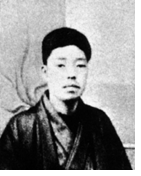

HISTORY OF HAIKU
10 haikuists and their works
Chapter 4
Shiki Masaoka (1867 ~ 1902)
 Shiki Masaoka appeared in the haiku world as the critic
to Basho Matsuo. Shiki criticized Basho's famous haikus in his criticism
"Basho Zatsudan" (Miscellanies about Basho). He didn't deny Basho's
all works, but he reproached his hokkus for lack of poetic purity and for
having explanatory prosaic elements.
Shiki Masaoka appeared in the haiku world as the critic
to Basho Matsuo. Shiki criticized Basho's famous haikus in his criticism
"Basho Zatsudan" (Miscellanies about Basho). He didn't deny Basho's
all works, but he reproached his hokkus for lack of poetic purity and for
having explanatory prosaic elements.
On the other hand, he extolled Buson Yosa who had been unrecognized yet. He thought that Buson's haikus are technically refined and they transmit efficiently clear impressions to readers.
After the discovery of the Western philosophy, Shiki convinced that laconic descriptions of things were effective for literary and pictorial expression. He insisted on the importance of "shasei" (sketching). This idea led his haikus to the visual description and to the concise style.
The haiku innovation by Shiki created a great sensation in the whole
of Japan and revived the languishing haiku world.
The tepid rain falls
On the bare thorn.
Thawed out pond.
A shrimp moves
Among old algae.
The cannon rolls its rumble.
Leaf buds of a tree.
How cool it is!
A small crab, in the rain,
Climbs on a pine.
Lotus leaves in the pond
Ride on water.
Rain in June.
Smoke whirls
After the passage of a train.
Young foliage.
The storm
During half-day
Has broken the stem of mallow.
We cannot see even the moon.
And rise big waves.
Above a hollow of rock
An ivy hangs.
One small temple.
The luffa flowered.
I am a soul
Choked with phlegm.
Shiki denied the value of haikai-renga and always used the word "haiku"
instead of " haikai" or " hokku ". Today, haikai-renga
is called "renku", but few specialists are interested in this
poetic form.
Written by
Ryu Yotsuya
Next Page (Kyoshi Takahama)
HOME / Index
French / Japanese
e-mail to Ryu Yotsuya and Niji Fuyuno
loupe@big.or.jp